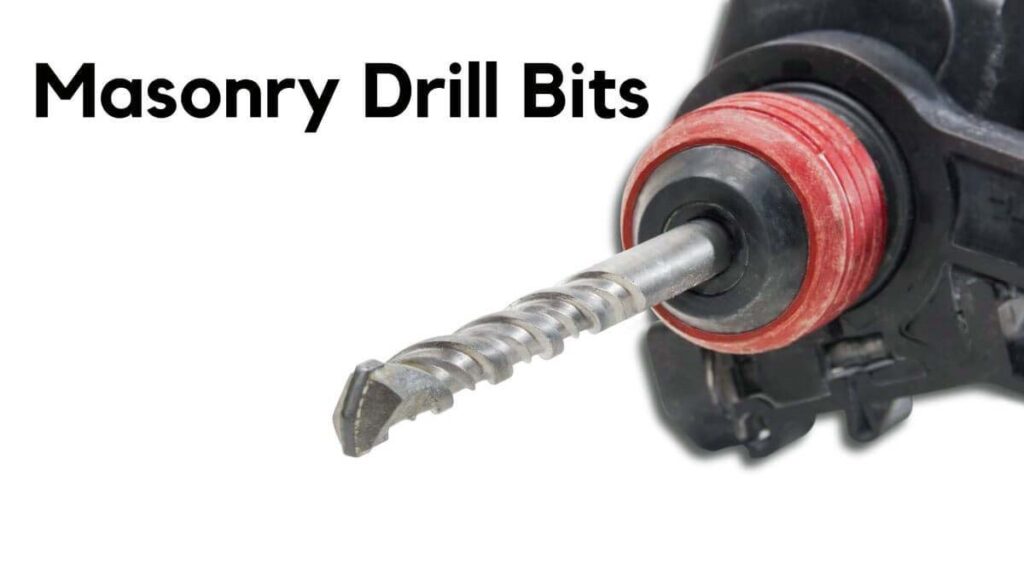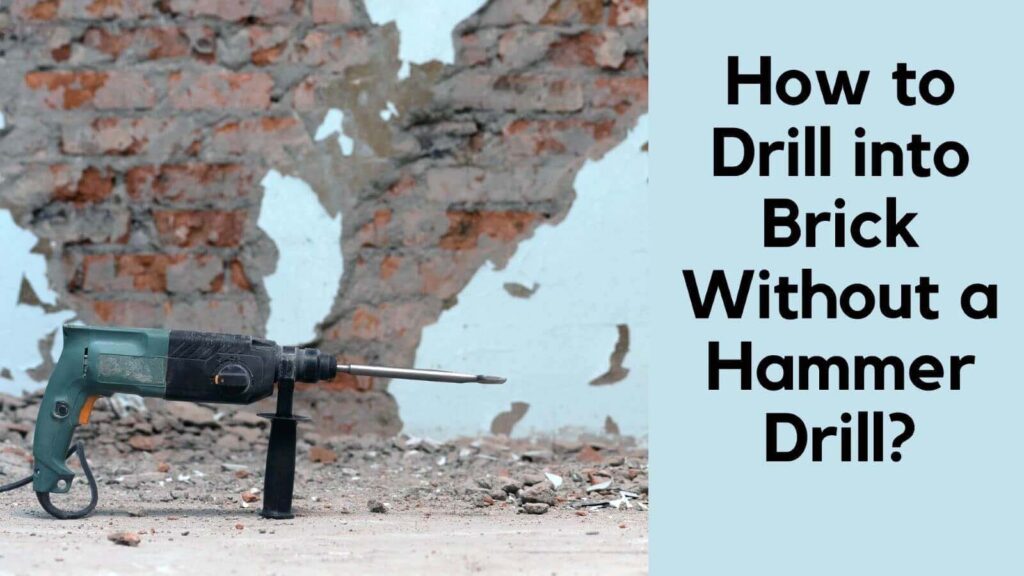Drilling into brick is a task that often intimidates DIY enthusiasts. While using a hammer drill is the most effective method for drilling into hard materials like brick and concrete, it’s not the only option. With the right approach and some patience, you can successfully drill into brick without needing a hammer drill. This blog post will cover ten easy tips for drilling into brick without a hammer drill, the tools you’ll need, and important safety precautions to follow.
Table of Contents
Do Masonry Drill Bits Work?

Yes, masonry drill bits work extremely well for drilling into hard materials like brick, concrete, stone, and mortar. They are specifically designed with tough, durable materials such as tungsten carbide tips, which allow them to cut through dense surfaces without becoming dull or damaged.
Here’s why masonry drill bits are essential for drilling into brick or similar materials:
1. Hardened Tips
Masonry drill bits feature tungsten carbide or similar materials at the tip, making them strong enough to penetrate hard materials like brick. This helps avoid cracks, chips, or damage to both the drill bit and the material.
2. Helical Flutes
These drill bits have spiraled flutes that are designed to help remove debris from the hole as you drill. This allows the bit to cut more effectively without clogging up, which can be a challenge when working with brick.
3. Efficient in Regular Drills
Even if you don’t have a hammer drill, masonry bits still work well with standard drills. They won’t be as fast as when used with a hammer drill, but by following proper techniques like drilling slowly and cooling the bit, you can achieve the desired results.
In summary, masonry drill bits are essential for effective drilling in brick and other hard materials, ensuring a clean and precise hole while protecting both your equipment and the material.
Check Also: Best Drills for Concrete.
Is a Hammer Drill Required to Drill a Brick?
While a hammer drill certainly makes the process easier and faster, it is not strictly required. A standard drill equipped with masonry bits can handle the job, although it may take more time and effort. With patience and the right technique, you can successfully drill into brick using a regular drill, following a step-by-step process that we will outline later in this post.
Read More: How to Drill a Hole in Wood Without a Drill?
What Is Concrete Brick?

Concrete brick is a type of brick that is made from a mixture of cement and aggregate, rather than clay. It’s denser and harder than traditional clay bricks, making it more challenging to drill through. If you’re working with concrete bricks, it may take more time to drill, and you’ll need to be particularly cautious to avoid cracking or damaging the material.
Read More: What Size Drill Bit for 1/2 Concrete Anchor?
What Other Tools Can You Use To Drill Into Brick?Apart from using a regular drill and masonry drill bits, there are a few other tools that can help you successfully drill into brick without a hammer drill:
Manual Drilling Tools: In some cases, you can use hand-crank drills, but this is a slow and labor-intensive process, best suited for softer materials.
Impact Driver: While it’s not a hammer drill, an impact driver delivers quick, rotational bursts that can assist in making drilling into brick easier.
Rotary Tool: Equipped with the correct attachments, a rotary tool can be used for smaller holes or detail work.
Read More: How to Drill a Hole in Plastic Without a Drill?
Step-By-Step Guide to Drilling Into Brick without a Hammer Drill
Here’s a step-by-step guide to help you drill into brick without the need for a hammer drill. These easy-to-follow instructions will ensure a smooth and safe process.
Step 1 – Stock Up on Several Different Sizes of Masonry Drill Bits.
Since brick is a hard material, starting with a small masonry drill bit and gradually working your way up to a larger size can reduce the strain on your drill. Having different sizes of masonry bits on hand is crucial for gradually increasing the size of the hole.
Step 2: Measure and Mark the Hole Locations
Use a pencil or masking tape to mark where you want to drill the hole. If possible, try to drill into the mortar between bricks rather than directly into the brick itself, as mortar is easier to penetrate.
Step 3 – Equip Yourself With Protective Gear
Drilling into brick produces a lot of dust and debris, so it’s important to protect yourself. Wear safety goggles, gloves, and a dust mask to prevent dust inhalation and protect your eyes.
Step 4 – Slowly Start Drilling With a Smaller Masonry Bit.
Attach a smaller masonry bit to your regular drill. Begin drilling slowly at the marked location, applying steady, gentle pressure. Keep the drill at a 90-degree angle to the surface to ensure a clean hole.
Step 5 – Keep a Supply of Water or Lubricant Nearby.
Drilling into brick generates a lot of heat, which can cause the drill bit to overheat. To prevent this, keep a bottle of water or lubricant nearby and apply it to the drill bit at intervals to cool it down.
Step 6 – Gradually Increase the Size of the Masonry Bits
Once you’ve drilled a pilot hole with the smaller bit, switch to a slightly larger bit and continue drilling. This step-by-step approach reduces strain on the drill and makes the process smoother.
Step 7: Dig Through the Blocks.
Continue drilling, allowing the bit to do the work rather than forcing it. You may encounter more resistance as you go deeper into the brick, so be patient and drill at a slow pace.
Step 8 – Lift the Drill Continuously Out of the Hole
As you drill, lift the drill bit out of the hole periodically to clear out dust and debris. This will help maintain the efficiency of the drilling process and prevent the bit from getting stuck.
Read More: What is a Hammer Drill?
Step 9 – Arrange for the Installation of Your Wall Anchor
If you’re drilling to insert a wall anchor, stop once you’ve reached the required depth. Clean the hole, insert the wall anchor, and secure it before attaching any fixtures.
Step 10 – Thoroughly Clean the Work Area of Any Remaining Garbage
After drilling, clean up the surrounding area to remove dust, debris, and small bits of brick. Use a vacuum or a brush to ensure the space is clean.
Check Also: Best Hammer Drills You Will Love.
Safety Precautions
Drilling into brick can be hazardous if proper safety precautions are not followed. Here are some essential safety tips to keep in mind:
- Wear Safety Gear: Always wear protective glasses, gloves, and a dust mask to protect yourself from dust and flying debris.
- Ensure Proper Ventilation: Drilling into brick produces a lot of dust. Make sure you’re working in a well-ventilated area or use a dust extractor.
- Avoid Excessive Force: Let the drill and the masonry bit do the work. Applying too much pressure can cause the bit to overheat, break, or damage the brick.
- Keep the Drill Cool: Drilling into hard surfaces like brick can generate significant heat. Stop periodically to cool the drill bit with water or lubricant.
FAQs About How to Drill into Brick Without a Hammer Drill
How to maintain a tungsten carbide drill bit’s sharpness?
To maintain the sharpness of your tungsten carbide masonry drill bits, clean them regularly and avoid overheating by using water or lubricant during drilling. Sharpen the tips if needed using a diamond file.
How to screw into a brick?
Screwing into brick can be tricky, but with the right tools and techniques, it’s straightforward. Whether you’re mounting a fixture, hanging a shelf, or attaching outdoor items to brick, the key is using the proper equipment and following careful steps to ensure the brick remains intact.
Can I use a regular drill for drilling into brick?
Yes, you can use a regular drill to drill into brick, but it will take more time and effort than using a hammer drill. Make sure to use high-quality masonry drill bits.
What if the drill bit gets stuck in the brick?
If the drill bit gets stuck, stop the drill and try to gently wiggle it free. Avoid applying too much force as this could break the bit or damage the brick.
Should I apply more pressure for faster drilling?
No, applying excessive pressure can damage the drill bit and the brick. Instead, let the drill and bit do the work, applying steady and moderate pressure.
Can I use a regular drill bit for masonry?
No, regular drill bits are not designed to cut through hard materials like brick. You should always use masonry drill bits for this purpose.
Can I use an impact driver instead of a regular drill?
An impact driver can be used, but it’s not ideal for drilling into brick. It delivers quick bursts of rotational force, which may help, but it’s best suited for driving screws rather than drilling holes.
Is water the only lubricant I can use?
While water is the most common and accessible lubricant for cooling the drill bit, you can also use specially designed cutting fluids or lubricants for masonry drilling.
Final Opinion
Drilling into brick without a hammer drill may seem challenging, but it’s entirely possible with the right tools, techniques, and patience. By using high-quality masonry bits, applying steady pressure, and following the steps outlined in this guide, you can achieve clean, precise holes without damaging the brick. Always prioritize safety, take your time, and you’ll have success in your drilling projects.
Whether you’re mounting shelves, installing fixtures, or working on a larger project, these ten easy tips will help you drill into brick effectively and safely.

Hey, I am MD Hrithik Hossain, I’m a huge fan of DIY crafts. My workshop is where I spend most of my spare time, and I’m always working on some project. To that end, I’d like to share some of my knowledge and experience with you in power tools, woodworking, and other specialized materials fabrication.
I will guide you with genuine knowledge that can assist you with deciding whether a drill is appropriate according to your requirements or not. If you want to find the best drill and know which type of drill is most suited for your needs, then I can guide you with my expertise. My passion lies in helping others find the correct products they need at an affordable price.


